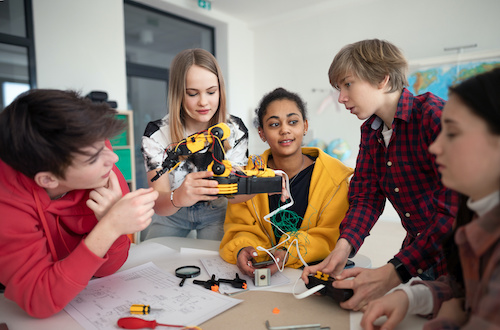Key points:
- Technology is great–but how can you use it to improve learning?
- Discover some of the best technologies that improve student learning
- Stay up-to-date on all things concerning learning in the digital age
In the modern educational landscape, leveraging technology is key to enhancing learning experiences. From interactive platforms to digital resources, incorporating technology optimizes accessibility, personalization, and engagement. New educational models delve into diverse ways individuals can use technology to bolster their learning in the digital age, fostering a dynamic and effective educational journey.
In the contemporary educational landscape, harnessing technology is pivotal to revolutionizing K-12 student learning. Integrating technology enhances engagement, personalization, and skill development.
How do you use technology to improve your learning?
The use of technology in the classroom to enhance teaching and learning is life changing. To enhance K-12 learning through technology, student can access interactive tools like educational apps and digital platforms into lessons, catering to diverse learning styles. Virtual reality applications and online simulations offer immersive experiences, making complex subjects tangible.
Encouraging collaborative projects through online platforms cultivates teamwork and communication skills. Additionally, personalized learning can be fostered with adaptive learning software, tailoring instruction to individual student needs. Implementing formative assessment tools provides real-time feedback, guiding instructional adjustments.
Overall, a strategic integration of technology in K-12 education empowers educators to create dynamic, engaging, and personalized learning environments that prepare students for the challenges of the digital age.
What is an example of technology as a learning tool?
Among technology tools for teaching and learning, an engaging example of technology as a K-12 learning tool is educational gamification platforms. These platforms, like Kahoot! or Quizizz, turn traditional lessons into interactive games, enhancing engagement and fostering a fun learning environment. Students participate in quizzes and challenges, applying knowledge in a gamified context. This approach not only makes learning enjoyable but also promotes healthy competition and active participation. Educational gamification tools are versatile, applicable across various subjects, and encourage critical thinking skills.
By integrating gamification into lessons, educators leverage technology to create an immersive and effective learning experience that goes beyond traditional methods, making complex concepts more accessible and enjoyable for K-12 students.
How does technology help students learn?
Technology significantly benefits K-12 students by offering diverse tools that cater to varied learning styles and enhance the overall educational experience. Examples of technologies that improve student learning include educational apps and interactive software engage students, which make learning enjoyable and accessible. Adaptive learning platforms tailor instruction, addressing individual needs and fostering a personalized learning journey. Online collaboration tools enable teamwork and communication skills, crucial for the future workforce. Virtual reality applications transport students to immersive environments, facilitating experiential learning.
Moreover, technology promotes digital literacy, essential for navigating the modern world. Online assessments provide instant feedback, guiding students toward continuous improvement. Coding programs and robotics kits introduce valuable STEM skills, fostering critical thinking and problem-solving. Overall, technology in K-12 education creates dynamic, interactive, and student-centered learning environments, preparing students with essential skills for the digital era and contributing to their overall academic success.
What are 3 benefits of using technology in education?
Using technology in K-12 education brings numerous benefits, enhancing the learning experience for students and educators alike. When we discuss the importance of technology in the classroom, firstly, technology promotes personalized learning by adapting to individual student needs, catering to diverse learning styles and paces. This customization fosters a deeper understanding of subjects.
Secondly, technology facilitates increased engagement through interactive and multimedia elements. Educational apps, online platforms, and digital resources make lessons more dynamic, capturing students’ attention and encouraging active participation.
Thirdly, technology cultivates essential 21st-century skills. Exposure to digital tools, coding platforms, and collaborative online environments prepares students for the demands of a technology-driven world, promoting skills such as critical thinking, problem-solving, and effective communication. Overall, integrating technology in K-12 education creates more adaptable, engaged, and future-ready learners.
Conclusion
Embracing technology in a K-12 learning journey can be transformative. From interactive apps for personalized learning to collaborative online platforms for teamwork, technology has optimized the educational experience. It promotes active engagement, adapts to a student’s pace, and prepares them for the digital future.
As students continue to navigate the ever-evolving landscape of education, technology remains a crucial ally, enriching learning, expanding possibilities, and cultivating skills essential for success in the 21st century.
- Classroom Learning - April 5, 2024
- Advantages and Disadvantages of Classroom Management - April 5, 2024
- What are Disadvantages of Classroom Management? - April 5, 2024

